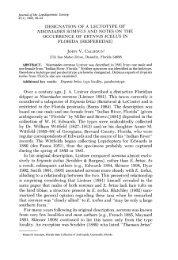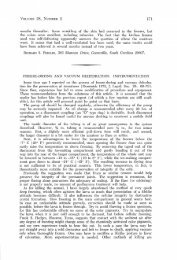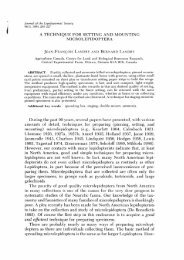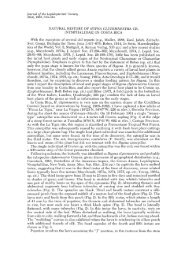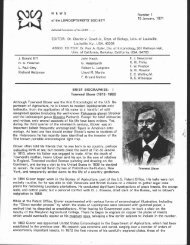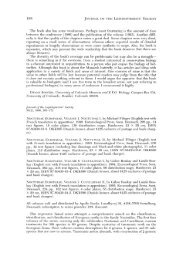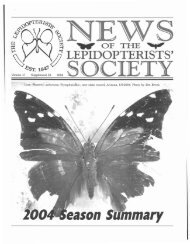Biology of Anaea ryphea - Yale University
Biology of Anaea ryphea - Yale University
Biology of Anaea ryphea - Yale University
You also want an ePaper? Increase the reach of your titles
YUMPU automatically turns print PDFs into web optimized ePapers that Google loves.
252 JOURNAL OF THE LEPIDOPTERISTS' SOCIETY<br />
usually feed on the same leaf through the third instar, reducing it to<br />
one-half or one-third its original size. From third instar on, feeding<br />
increases noticeably. Larvae can move to another leaf and build a new<br />
tube if the first leaf is consumed before pupation, but that rarely was<br />
seen. More commonly they visit another leaf just to eat, then return to<br />
the old leaf where the shelter is kept (they never eat the roll). Feeding<br />
takes place mainly from dusk to dark, as do molting and pupation.<br />
When not eating, larvae remain on the mid vein or inside the tube.<br />
During the last instar, the larva abandons the plant and searches for a<br />
suitable place to pupate.<br />
Early Stages<br />
Egg (Fig. 3). Approximately 1 mm in diameter (n = 10). Spherical, with small depression<br />
on top (micropyle end), greenish white, with no conspicuous sculpturing. Duration 5-6<br />
days.<br />
First Instar (Fig. 5). Length 1.5-8.0 mm (n = 1161). Head brown with dark brown<br />
spots, lighter near foramen; epicranial suture complete, well marked. Body eruciform,<br />
hazel, darker posteriorly. Duration approximately 6 days (n = 278).<br />
Second Instar (Fig. 4). Length 5-14 mm (n = 598). Head light brown with three dark<br />
stripes on each side; frons with central dark stripe; pair <strong>of</strong> small scoli (each with two<br />
setae) on vertex, scattered chalazae restricted to sides <strong>of</strong> head. Body pale greenish brown<br />
with pale spots throughout, slightly enlarged on second abdominal segment. Duration<br />
approximately 6 days (n = 155).<br />
Third Instar (Fig. 6). Length 8-20 mm (n = 308). H ead similar to that <strong>of</strong> second instar,<br />
but with a series <strong>of</strong> dark spots between the three dark stripes <strong>of</strong> the epicranium, also<br />
some dark dots around the foramen; scoli larger than on second instar, with more chalazae.<br />
Body green, except second, fifth, and seventh abdominal tergi, which are brown; second<br />
abdominal segment enlarged, forming a small dorsal hump. Duration approximately 7<br />
days (n = 105).<br />
Fourth Instar (Fig. '7). Length 14-24 mm (n = 30l). Head similar to third instar, with<br />
dark stripes more pronounced, scoli resembling antlers, and chalazae all over head. Body<br />
brownish green, with dark brown subdorsal stripes following second and third thoracic<br />
segments, turning dorsal and joining to form a broad dorsal band across the first and<br />
second abdominal segments; fourth through tenth abdominal segments also with dark<br />
brown subdorsal stripe; third abdominal segment entirely green. Hump on second abdominal<br />
segment more conspicuous than in previous instar. Duration approximately 7<br />
days (n = 83).<br />
Fifth Instar (Fig. 8). Length 20-28 mm (n = 273). Remarkably distinct from previous<br />
instars. Head green; scoli large, Y -shaped; chalazae present in greater density. Body bright<br />
green, with black dots on dorsal and lateral surfaces <strong>of</strong> all segments; second, fifth, and<br />
seventh abdominal segments with reddish hazel subdorsal stripes. Duration 8-15 days (n<br />
= 45).<br />
Pre-pupa (Fig. 9). Green, curled horizontally rather than vertically as in other nymphalids,<br />
and appressed to its support. Duration 2 days (n = 12).<br />
Pupa (Fig. 10). Green, naked; dark cremaster attached to white silken pad. Duration<br />
approximately 12 days (n = 12).<br />
The duration <strong>of</strong> the early stages in the field requires 50-60 days,<br />
accounting for individual variation. The pattern <strong>of</strong> development <strong>of</strong><br />
<strong>Anaea</strong> <strong>ryphea</strong> is sjimilar to that described for <strong>Anaea</strong> (Zaretis) itys on





